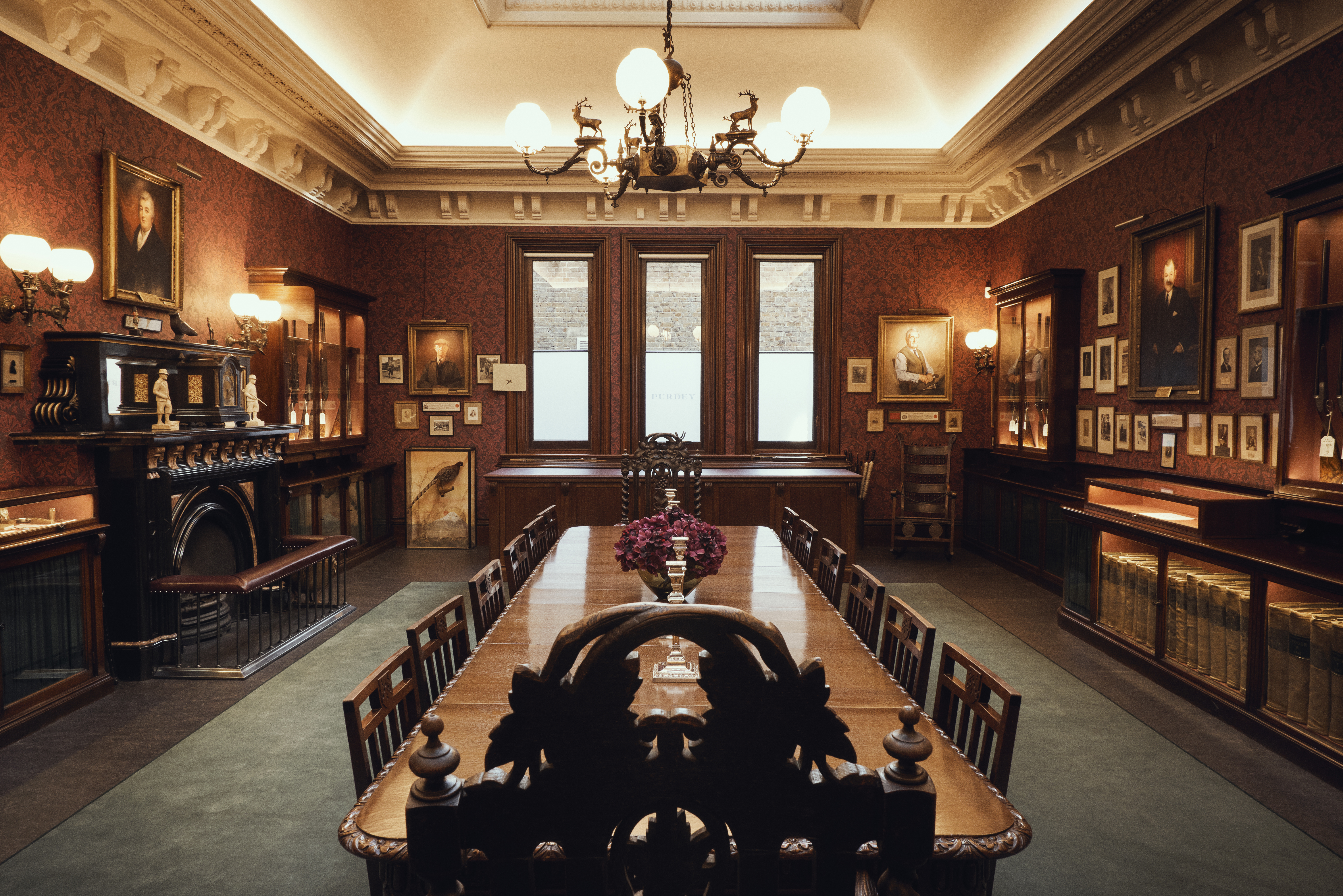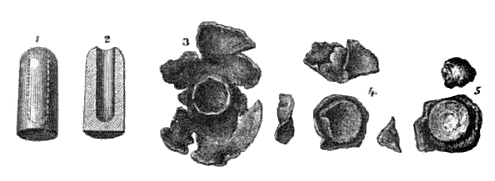|
Double Rifles
The double rifle, also known as a double-barreled rifle, is a rifle with two barrels mounted parallel to each other that can be fired simultaneously or sequentially in quick succession. Synonymous with big game hunting found primarily in Africa and Asia, the double rifle is a sporting weapon with very little military heritage. Design The double rifle is usually handcrafted and is considered by many to be the pinnacle of sporting rifle design. It is not designed for long-range accuracy but instead for the security of an immediate second shot. Double rifles are similar to double-barreled shotguns. Action As with double-barrelled shotguns, modern double rifles are all made with either sidelock or boxlock actions, although occasionally old hammer rifles can be found. The majority of double rifles have been built on the boxlock actions as it is a simpler design with fewer moving parts that can fail. Consequently, it has an outstanding reputation for reliability. The sidelock action ... [...More Info...] [...Related Items...] OR: [Wikipedia] [Google] [Baidu] |
Shot (pellet)
Shot is a collective noun, collective term for small spheres or pellets, often made of lead. These have been projected from Sling (weapon), slings since ancient times and were the original projectiles for shotguns and are still fired primarily from shotguns and grenade launchers, while they are less commonly used in riot guns. Shot shells are also available in many handgun calibers in a configuration known as "birdshot", "rat shot", or "snake shot". Lead shot is also used for a variety of other purposes such as filling cavities with dense material for weight and/or balance. Some versions may be plated with other metals. Lead shot was originally made by pouring molten lead through screens into water, forming what was known as "swan shot", and, later, more economically mass-produced at higher quality using a shot tower. The ''Bliemeister method'' has supplanted the shot tower method since the early 1960s. Manufacture Producing lead shot from a shot tower was pioneered in the l ... [...More Info...] [...Related Items...] OR: [Wikipedia] [Google] [Baidu] |
6 Bore
The 6 bore, also known as the 6 gauge, is an obsolete caliber that was used commonly in 19th-century black-powder firearms. Design The 6 bore is a caliber firearm, used both as a shotgun firing shot and solid projectiles from muzzleloaders and breech loaders, both in smoothbore and rifled long guns. Late breech loaders were designed to fire cartridges. A 6 bore cartridge rifle built by W.W. Greener in 1891 for a southern African trekker called Viljoen, fired bullets at . Three types of ammunition were supplied, hardened lead for elephants and rhinoceros, slightly hardened lead for buffalo, and pure lead with a copper tube hollow point for lion. History Early 6 bores tended to be large muzzle loading shotguns that were used for wildfowling. While designed to fire shot, experiences with dangerous game in Africa and India led to them also being loaded with solid projectiles. These projectiles were usually propelled by a double charge of black powder. By the 1850s, the iv ... [...More Info...] [...Related Items...] OR: [Wikipedia] [Google] [Baidu] |
8 Bore
The 8 bore (Commonwealth English), also known as the 8 gauge (American English), is an obsolete caliber used commonly in the 19th-century Black powder, black-powder firearms for Big-game hunting, hunting large dangerous game. Design An 8 bore is a caliber firearm. Historically it was used to fire bullet, solid projectiles from smoothbores, rifling, rifles, and partially rifled ball and shot guns, as well as shot (pellet), shot from muzzleloader, muzzle-loading and Breech-loading weapon, breech-loading shotguns. Later breech loaders were designed to fire Cartridge (firearms), cartridges. History Shot loadings The 8 bore was a popular wildfowling calibre both in muzzleloaders and later cartridge shotguns. 8 bore cartridges were available in multiple lengths including 3-inch, 3¼-inch, 3¾-inch and 4-inch. Solid loadings When the Dutch Republic, Dutch established the Dutch Cape Colony in the 17th century, they soon discovered their muskets were hopelessly inadequate against loc ... [...More Info...] [...Related Items...] OR: [Wikipedia] [Google] [Baidu] |
James Purdey
James Purdey & Sons, or simply Purdey, is a British gunmaker based in London, England specialising in high-end bespoke sporting shotguns and rifles.Ten of the world's finest shotguns '''', 24 January 2008. Archived fro the original on 4 October 2022. Retrieved 27 February 2023 Purdey holds Royal Warrants of appointment as gun and rifle makers to the |
Express (weaponry)
The term ''express'' was first applied to hunting weapon, hunting rifles and ammunition beginning in the mid-19th century, to indicate a rifle or ammunition capable of higher than typical velocities. The early express cartridges used a heavy charge of black powder to propel a lightweight, often hollow point bullet, at high velocities to maximize point blank range. Later the express cartridges were loaded with nitrocellulose-based gunpowder, leading to the Nitro Express cartridges, the first of which was the .450 Nitro Express. The term ''express'' is still in use today, and is applied to rifles, ammunition, and a type of iron sight. With the widespread adoption of small bore, high velocity rifle cartridges, the meaning of ''express'' has shifted in modern usage, and refers to high velocity, large bore rifles and ammunition, typically used for hunting large or dangerous game at close range. History The name originates with a rifle built by James Purdey in 1856 (based on a patte ... [...More Info...] [...Related Items...] OR: [Wikipedia] [Google] [Baidu] |
Rifling
Rifling is the term for helical grooves machined into the internal surface of a firearms's barrel for imparting a spin to a projectile to improve its aerodynamic stability and accuracy. It is also the term (as a verb) for creating such grooves. The opposite of rifling is smoothbore. Rifling is measured in ''twist rate'', the distance the rifling takes to complete one full revolution, expressed as a ratio with 1 as its base (e.g., 1:). A shorter distance/lower ratio indicates a faster twist, generating a higher spin rate (and greater projectile stability). The combination of length, weight, and shape of a projectile determines the twist rate needed to gyroscopically stabilize it: barrels intended for short, large-diameter projectiles such as spherical lead balls require a very low twist rate, such as 1 turn in 48 inches (122 cm). Barrels intended for long, small-diameter projectiles, such as the ultra-low-drag 80-grain 0.223 inch bullets (5.2 g, 5.56&nb ... [...More Info...] [...Related Items...] OR: [Wikipedia] [Google] [Baidu] |
Percussion Cap
The percussion cap, percussion primer, or caplock, introduced in the early 1820s, is a type of single-use percussion ignition device for muzzle loader firearm locks enabling them to fire reliably in any weather condition. Its invention gave rise to the caplock mechanism or percussion lock system which used percussion caps struck by the hammer to set off the gunpowder charge in rifles and cap and ball firearms. Any firearm using a caplock mechanism is a percussion gun. Any long gun with a cap-lock mechanism and rifled barrel is a percussion rifle. Cap and ball describes cap-lock firearms discharging a single bore-diameter spherical bullet with each shot. Description The percussion cap is a small cylinder of copper or brass with one closed end. Inside the closed end is a small amount of a shock-sensitive explosive material such as mercury fulminate (discovered in 1800; it was the only practical detonator used from about the mid-19th century to the early 20th century). ... [...More Info...] [...Related Items...] OR: [Wikipedia] [Google] [Baidu] |
Flintlock
Flintlock is a general term for any firearm that uses a flint-striking lock (firearm), ignition mechanism, the first of which appeared in Western Europe in the early 16th century. The term may also apply to a particular form of the mechanism itself, also known as the ''flintlock mechanism, true flintlock'', that was introduced in the early 17th century, and gradually replaced earlier firearm-ignition technologies, such as the matchlock, the wheellock, and the earlier flintlock mechanisms such as the snaplock and snaphaunce. The true flintlock continued to be in common use for over two centuries, replaced by percussion cap and, later, the Cartridge (firearms), cartridge-based systems in the early-to-mid 19th century. Although long superseded by modern firearms, flintlock weapons enjoy continuing popularity with Black powder, black-powder shooting enthusiasts. History French court gunsmith Marin le Bourgeoys made a firearm incorporating a flintlock mechanism for King Louis XIII ... [...More Info...] [...Related Items...] OR: [Wikipedia] [Google] [Baidu] |
Muzzleloader
A muzzleloader is any firearm in which the user loads the bullet, projectile and the propellant charge into the Muzzle (firearms), muzzle end of the gun (i.e., from the forward, open end of the gun's barrel). This is distinct from the modern designs of Breechloader, breech-loading firearms, in which user loads the ammunition into the Chamber (firearms), breech end of the gun barrel, barrel. The term "muzzleloader" applies to both rifled and smoothbore type muzzleloaders, and may also refer to the marksman who specializes in the shooting of such firearms. The firing methods, paraphernalia and mechanism further divide both categories as do caliber (from cannons to small-caliber palm guns). Modern muzzleloading firearms range from reproductions of sidelock, flintlock and percussion cap, percussion long guns, to in-line rifles that use modern inventions such as a closed breech, sealed percussion cap, primer and fast rifling to allow for considerable accuracy at long ranges. Modern Mo ... [...More Info...] [...Related Items...] OR: [Wikipedia] [Google] [Baidu] |
Smoothbore
A smoothbore weapon is one that has a barrel without rifling. Smoothbores range from handheld firearms to powerful tank guns and large artillery mortars. Some examples of smoothbore weapons are muskets, blunderbusses, and flintlock pistols. The opposite of smoothbore is rifling. History Early firearms had smoothly bored barrels that fired projectiles without significant spin. To minimize inaccuracy-inducing tumbling during flight, their projectiles required an aerodynamically uniform shape, such as a sphere. However, surface imperfections on the projectile and/or the barrel will cause even a sphere to rotate randomly during flight, and the Magnus effect will curve it off the intended trajectory when spinning on any axis not parallel to the direction of travel. Rifling the bore surface with spiral grooves or polygonal valleys imparts a stabilizing gyroscopic spin to a projectile that prevents tumbling in flight. Not only does this more than counter Magnus-induced drift, ... [...More Info...] [...Related Items...] OR: [Wikipedia] [Google] [Baidu] |
Black Powder
Gunpowder, also commonly known as black powder to distinguish it from modern smokeless powder, is the earliest known chemical explosive. It consists of a mixture of sulfur, charcoal (which is mostly carbon), and potassium nitrate, potassium nitrate (saltpeter). The sulfur and charcoal act as fuels while the saltpeter is an oxidizer. Gunpowder has been widely used as a propellant in firearms, artillery, rocketry, and pyrotechnics, including use as a blasting agent for explosives in quarrying, mining, building Pipeline transport, pipelines, tunnels, and road#Construction, roads. Gunpowder is classified as a Explosive#Low, low explosive because of its relatively slow decomposition rate, low ignition temperature and consequently low brisance, brisance (breaking/shattering). Low explosives deflagration, deflagrate (i.e., burn at subsonic speeds), whereas high explosives detonation, detonate, producing a supersonic shockwave. Ignition of gunpowder packed behind a projectile generates ... [...More Info...] [...Related Items...] OR: [Wikipedia] [Google] [Baidu] |









